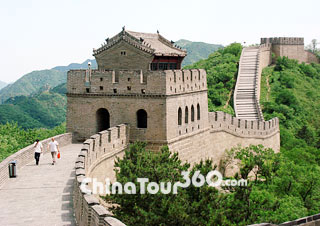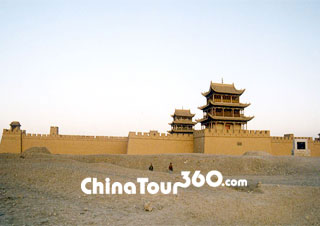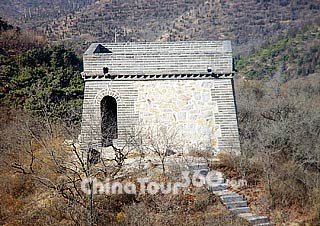 Badaling Great Wall
Badaling Great Wall Jiayuguan Pass
Jiayuguan Pass A Signal Tower, Badaling
A Signal Tower, Badaling
1 2 3
As a significant component of the defensive system of the Great Wall, beacon towers were high platforms built every 10 Li (3.1 miles). Also called beacons, smoke signal towers, or pavilion, they were used to observe enemies and send military messages in ancient times.
 History
History
Beacon towers actually appeared earlier than the Great Wall. The tower on the top of Lishan Mountain in Xian, Shaanxi Province, was built in the West Zhou Dynasty (11th Century - 771 BC), while the earliest wall was constructed in the East Zhou Dynasty (770 BC - 221 BC). In the Spring and Autumn Period (770 BC - 476 BC) and Warring States Period (476 BC - 221 BC), when principalities fought each other for territory, the towers were connected with walls, forming the earliest Great Walls. In the Han Dynasty (206 BC - 220), beacon towers were called Ting (pavilion), Sui (beacon fire), or Tingsui (pavilion of beacon fire). As the towers played important role in defending against enemies, the Han government paid close attention to the construction. At some sections of the Great Wall closely spaced towers even replaced the walls. The towers were called Fengtai (a platform of beacon fire) in the Tang (618 - 907) and Song (960 - 1279) Dynasties. In the Ming Dynasty (1368 - 1644), the towers were called Yandun (smoke signal towers) or Duntai (abutment).
 Structure
Structure
Most towers were built as square or rectangle solid platforms, with a length of 4 to 8 meters for one side and a height of 4 to 10 meters. Built on the top of a tower was a house for the watchmen and the devices for lighting a fire. There were also houses for the watchmen and barns to keep sheep and horses under the towers, but most were destroyed. As were the walls, the towers were made of local materials. Rammed earth was the major material in the Northwest, while rocks were widely used in mountainous areas. Bricks towers or brick-covered towers were mostly found along the Ming-Dynasty walls in the middle and eastern areas of China.
 Categories
Categories
Beacon towers fall into four types in terms of the location and function:
 Yanbian Beacon Tower - the towers were closely beside the wall (some are built on the wall in the Qin and Han Dynasties), so that it was easy to muster the garrison troops.
Yanbian Beacon Tower - the towers were closely beside the wall (some are built on the wall in the Qin and Han Dynasties), so that it was easy to muster the garrison troops.
 Fuwaijiehuo Beacon Tower - this kind of tower was built far outside the walls to observe enemies and send prompt messages.
Fuwaijiehuo Beacon Tower - this kind of tower was built far outside the walls to observe enemies and send prompt messages.
 Funeijiehuo Beacon Towers - the towers were inside of the wall and connected with the capital city for repaid communication.
Funeijiehuo Beacon Towers - the towers were inside of the wall and connected with the capital city for repaid communication.
 Jiadao Beacon Towers - this type of tower was far fromwalls, but was actually located on special passages connecting walls and the key relay points for sending messages to nearby towns.
Jiadao Beacon Towers - this type of tower was far fromwalls, but was actually located on special passages connecting walls and the key relay points for sending messages to nearby towns.
 How the Beacon Tower Worked
How the Beacon Tower Worked
A message was sent by lighting fires at night and releasing smoke in daytime. The number of fires or amount of smoke indicated the size of the enemy force. Flags were also used in daytime. In addition, cannon fire was also used to send military messages during the Ming Dynasty. Apart from sending messages, the towers also served as shelters and stations providing accommodation for passing ambassadors.
Beacon towers actually appeared earlier than the Great Wall. The tower on the top of Lishan Mountain in Xian, Shaanxi Province, was built in the West Zhou Dynasty (11th Century - 771 BC), while the earliest wall was constructed in the East Zhou Dynasty (770 BC - 221 BC). In the Spring and Autumn Period (770 BC - 476 BC) and Warring States Period (476 BC - 221 BC), when principalities fought each other for territory, the towers were connected with walls, forming the earliest Great Walls. In the Han Dynasty (206 BC - 220), beacon towers were called Ting (pavilion), Sui (beacon fire), or Tingsui (pavilion of beacon fire). As the towers played important role in defending against enemies, the Han government paid close attention to the construction. At some sections of the Great Wall closely spaced towers even replaced the walls. The towers were called Fengtai (a platform of beacon fire) in the Tang (618 - 907) and Song (960 - 1279) Dynasties. In the Ming Dynasty (1368 - 1644), the towers were called Yandun (smoke signal towers) or Duntai (abutment).
Most towers were built as square or rectangle solid platforms, with a length of 4 to 8 meters for one side and a height of 4 to 10 meters. Built on the top of a tower was a house for the watchmen and the devices for lighting a fire. There were also houses for the watchmen and barns to keep sheep and horses under the towers, but most were destroyed. As were the walls, the towers were made of local materials. Rammed earth was the major material in the Northwest, while rocks were widely used in mountainous areas. Bricks towers or brick-covered towers were mostly found along the Ming-Dynasty walls in the middle and eastern areas of China.
Beacon towers fall into four types in terms of the location and function:
A message was sent by lighting fires at night and releasing smoke in daytime. The number of fires or amount of smoke indicated the size of the enemy force. Flags were also used in daytime. In addition, cannon fire was also used to send military messages during the Ming Dynasty. Apart from sending messages, the towers also served as shelters and stations providing accommodation for passing ambassadors.







